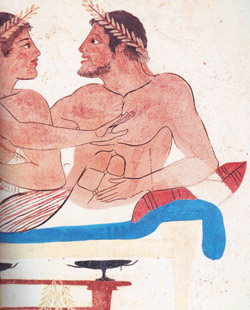|
|
Apartments in Florence, Perugia, Rome, Sorrento and Positano |




|
|
|
|
- You are in: Home » musei » NATIONAL ARCHAEOLOGICAL MUSEUM - Paestum - Salerno -
NATIONAL ARCHAEOLOGICAL MUSEUM - Paestum - Salerno -

We find many magnificent examples of the Greek religious architecture in various areas of Magna Gaecia, where the Greek seed brought by the intensive colonization, put forth shoots and in due time produced very good fruits, thanks also to the fertile Italian ground. As we have already said, in this prosperous province art became more lively and colourful, while architecture distinguished itself thanks to some new kinds of decorative
elements that made the severe Doric style more graceful, and also to its polychromatic terracotta decorations.
Unfortunately nothing remains of the sculptures of the frontons. We have, however, many metopes providing us with significant examples of such a decorative problem. Up to now Greek metopes (in Italy) have been found in Selinunte, Sicily (now kept in the National Museum of Palermo) and in the HERAION (the Sanctuary of Hera or Juno) situated at the mouth of river Sele (at 12 km to the North of Paestum) and are exhibited in the Museum of Paestum.
The Heraion was discovered in 1934. The ancients thought that it had been built by Jason and his Argonauts. It included a temple dedicated to Juno and various Thesauròi (sort of votive chapels) belonging to various towns and populations of the ancient Greek world.
A good number of small terracotta statues of Juno (kept now in this Museum) have been found in this area. They date back to the VII century b.C. The earliest sculptures represented the goddess seated on a throne with a child on her left arm and a pomegranate (a fruit sacred to her) in her right hand. In later statues (IV century b.C.) the goddess is represented as Hera Eilithia (that is, as a lying-in woman), naked and kneeling with winged geniuses behind her. She was worshipped as goddess of fertility and love.
TOMB OF THE DIVER
From the archaeological point of view, the discovery in 1968 of the Diver’s Tomb was the most extraordinary find of the century. In fact, for the first time, we are before some Greek paintings dating from a period between 480 and 470 b.C. No other Greek frescoed tomb, belonging to that period, had ever been found. Even in the Greek territories of Southern Italy there are no frescoed tombs, except in the Apulia area, where at times the sarcophagi are painted only inside with geometrical and floral decorations.
The Diver’s Tomb is not all different outwardly from the numberless tombs found around Paestum. It is a normal box-shaped tomb, that is formed by five calcareous slabs. What gives unity to the whole is that its inside walls (including the covering slab) area completely frescoed.
Now let us describe the five frescoes:
1) On the first long side we see a banquet with two personages making love and three others playing kottabos. Notice their sensual expressions, such as the slightly open mouth on the first personage on the right. Notice also the third personage from right: taking his mind of the game, he turns back to look at the erotic approach betwwen the first personage and the ephebe, showing interest together with lust and irony.
2) On the second long side, another scene representing a funeral banquet, with singers, a flutist and a lyre player.
3) On the first short side we see a naked ephebe pouring wine from a vase placed on a table adorned with festoons.
4) On the second short side, we see a man wearing a cloak and leaning on a stick, then a dancing ephebe preceded by a girl in white playing a flute ( the only feminine figure in these frescoes).
5) On the covering slab we see the representation after which the tomb has been named. In an open space, delimited and emphasized by two elegant small trees, a naked man dives into a sheet of blue water from a diving-board. Perhaps this elegant fresco represents the soul leaving this life and passing in the hereafter, symbolized by the wonderful plunge into the water.
museums archive
|
|
|
|
|
|
| TOP DESTINATIONS
|
| Adria Coast, Aeolian Islands, Alessandria, Altopiano Delle Rocche, Amalfi Coast, Aosta, Assisi, Asti, Bari, Brescia, Capo Vaticano, Capri, Catanzaro, Chianti, Cilento, Cinque Terre, Coast Of Marche, Conero Coast, Dolomites, Egadi Islands, Elba, Florence, Garda Lake, Gargano, Ischia, Italian Riviera, Lake Como , Langhe Piedmont, Lecce, Lucca, Lunigiana, Macerata, Mantova, Maremma Tuscany, Monferrato, Montepulciano, Naples, Perugia, Pesaro Urbino, Pisa, Pistoia, Positano, Prato, Procida, Riviera Of Palms, Rome, Salento Coast, Salerno, San Gimignano, Sardinia, Sicily, Siena, Sorrento, Terni, Tiber Valley Of Tuscany, Treviso, Turin, Val Gandino, Veneto, Venice, Viterbo |
|
|





